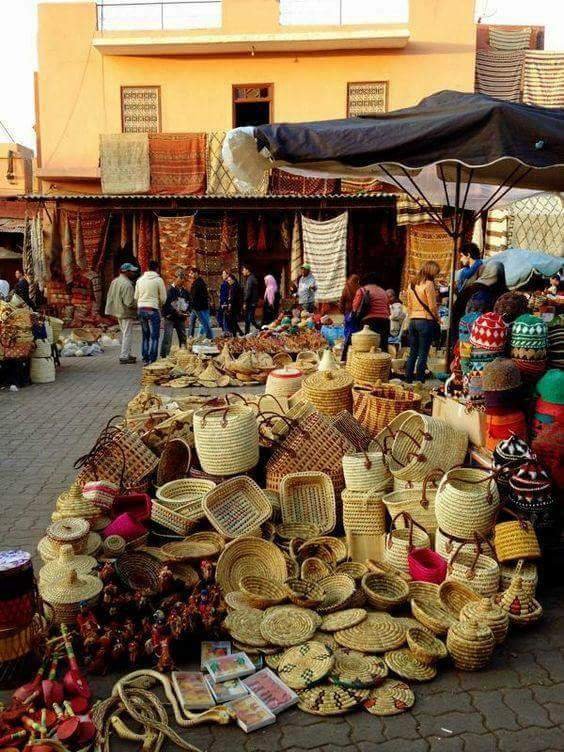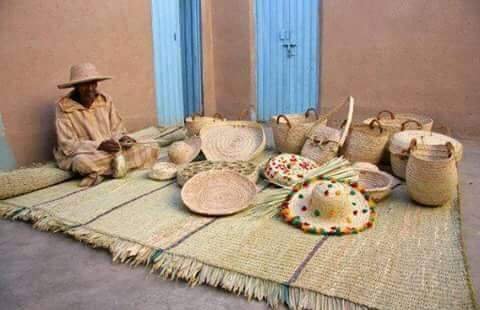
Handicrafts, whose products have become part of the Moroccan folklore, have become generations-old, but the wave of return to the "old" has revived products that have been extinct in recent decades.
Among these craft products are straw handicrafts, but through modern forms adapted to modern life having been transformed by skillful craftsmen into colorful dishes and attractive household items. It is generally said that straw preserved its place, and replaced it with furniture and decorations, but turned to paintings hung on the walls of houses alongside paintings and antiques. Recently, several handicrafts have emerged that are related to hay, characterized by their art and creative forms, such as those prevalent in most of the Moroccan countryside and in the old city neighborhoods. Some women are keen to make hay tools and make attractive shapes and drawings to beautify the house.
Women and girls usually compete to make straw products, baskets, dishes, etc. The competition is above all for the speed of delivery and the creation of new fees to be introduced. These dishes are often used to pick figs, grapes and some other fruits, so they are made before the harvest season. They also want to use baskets especially to carry or store grains such as wheat, chickpeas and lentils.
On the other hand, there is a keen interest in making colorful dishes, after dyeing the straw in multiple colors, which is usually allocated to put the bread, and therefore should be distinct from those ordinary dishes used in the fields and orchards. Bread dishes therefore require color and formal beauty as well as the high skill, precision of manufacture and the quality of straw sticks used in their manufacture.
In recent times, the profession or profession of straw industry has declined significantly after the emergence of new tools, and the adoption of farmers in the harvest of wheat on machines that take away the grain is not suitable for straw industry, but there are still some interested in hay industries after re-existence differently. "The manufacture of straw dishes that were used for a long time in the countryside until the 1980s, as used in ancient Arab homes for centuries, came back to the fore after multiple uses of its products," said Said Zitouni, a skilled craftsman in the industry. "The straw dish was only for the main meals, breakfast, lunch and dinner, as well as other household uses, and the straw was passed from home to farmland, carried over the head of rural women. Now it is rarely used in houses, but it has become a heritage painting with its various colors and beautiful colors, well worthy to be attached to the walls of houses as part of the modern decoration ».
"This handicraft industry has been associated with the former countryside and is based on hay extracted from wheat, maize and barley," said craftsman Idris Musawi. This simple plant material is produced after harvesting by hand, ie, the beehive. Rural women take the schnapps they think are suitable for making dishes, best of long-legged and high-caliber ears. The head is separated from the leg and the covers that line the leg are removed. The waste is neglected from its food crop, but it is useful to make useful tools of straw needed by the house always ». "Despite the simplicity of this material and the sense that it is from the trash, it is the basic and durable material for folk craftsmanship practiced by rural women in particular, and we are now practicing it to make many beautiful forms after straw products became famous heritage."
"I started working in this profession since I was 15 years old. I loved this industry because it is a manual profession that requires mastery and innovation. It fills the void with useful work and the raw material is available in rural areas. But it has been decreasing in the last two decades because of the adoption of the most farmers on the harvest machine, but we get our needs of wheat buckwheat to continue our profession inherited to the conviction of its value, and admiration for them, after it began to achieve prosperity and the satisfaction of tourists and is considered old folklore ».
"We bring the right straw to this industry, we clean it in large lathes slowly, we unload it, we take away the remains of the harvest, and then we do dyeing and coloring after putting it in," says Ahmed Sadeghi, a specialist in the industry for years. A brass vase over the fire with the dye, water and amount of salt. And then we set the colors well so as not to mix. Then, after boiling, dry the colored straw under the sun, and then start the process of manufacturing, we put the straw we need to work immediately with cold water within an hour, and then carry the straw of water and let it dry, and make the model required. The models are often unsuitable for private domestic use, as in the past when dishes and baskets were basic food items or intended for the transfer of field crops, and now we are preparing them for decoration and decoration because the straw implements restore contemporary human memory to the beautiful past.
As for the requirements of the straw industry, he concludes: "Straw must be soft during the industry process. When I create a model, I deliberately overlap the colors according to the harmony of each other, and create some drawings from my imagination and transfer them to paper. Sometimes I take advantage of the plastic paintings and calligraphy plates and transfer some of their contents to the straw dishes and achieve the technical task of this industry ».
Source

الصناعات اليدوية التي صارت منتجاتها جزءا من التراث الشعبي المغربي، وغدت مهنا تتوارثها الأجيال، بيد أن موجة العودة إلى «القديم» أعادت إحياء منتجات شارفت خلال العقود الأخيرة على الانقراض.
ضمن هذه المنتجات الحرفية العائدة إلى الساحة مصنوعات القش، ولكن من خلال أشكال مستحدثة لتتناسب مع الحياة العصرية بعدما حوّلتها أيادي صناع مهرة إلى أطباق ملونة وأدوات منزلية جذابة. ويمكن القول عموما إن القش حافظ على مكانته، واحتل مكانه بين الأثاث المنزلي والديكورات، بل تحول إلى لوحات علقت على جدران المنازل إلى جانب اللوحات والتحف. وفي الآونة الأخيرة برزت حرف يدوية عدة متصلة بالقش تتميز بفنياتها وأشكالها الإبداعية، ومنها تلك التي كانت سائدة في معظم الأرياف المغربية، وفي أحياء المدن العتيقة، حيث تحرص بعض النساء على صنع أدوات القش وإنجاز أشكال ورسوم جذابة، لإضفاء جمالية على البيت.
وعادة ما تتنافس النسوة والفتيات على إنجاز مصنوعات من القش، كالسلال والأطباق وما إليها، ويكون التنافس قبل كل شيء على سرعة الإنجاز، وابتكار رسوم جديدة يتم إدخالها عليها. وغالبا ما تستعمل هذه الأطباق والسلال لقطاف التين والعنب وبعض الفواكه الأخرى، ولذا فإنها تصنع قبل موسم القطاف، كما يرغب في استخدام السلال خصوصا لحمل أو تخزين الحبوب كالقمح والحمص والعدس.
من ناحية ثانية، ثمة حرص شديد على صنع الأطباق الملونة، بعد صبغ القش بألوان متعددة، التي تخصص عادة لكي يوضع عليها الخبز، وبالتالي يجب أن تكون متميزة عن تلك الأطباق العادية التي تستعمل في الحقول والبساتين. وبذا تحتاج أطباق الخبز إلى الجمال اللوني والشكلي بالإضافة إلى ما تتطلبه من المهارة الشديدة ودقة الصنع وجودة أعواد القش المستعملة في صناعتها.
في الآونة الأخيرة تراجعت مهنة أو حرفة صناعة القش كثيرا بعد ظهور أدوات جديدة، واعتماد المزارعين في حصاد القمح على الآلات التي تنزع الحبوب فلا تغدو السنابل صالحة لصناعة القش، إلا أنه ما زال هناك بعض المهتمين بصناعات القش بعدما أعادت وجودها بشكل مختلف. ويقول سعيد الزيتوني، وهو من الحرفيين المهرة في هذه الصناعة «صناعة أطباق القش التي استعملت فترة طويلة في الأرياف حتى عقد الثمانينات، كما استعملت في البيوت العربية القديمة لقرون خلت، عادت إلى الواجهة بعد تعدد استعمالات منتجاتها». ويتابع الزيتوني شارحا «كان الطبق المصنوع من القش مخصصا لتقديم وجبات الطعام الرئيسية فقط، وهي الفطور والغداء والعشاء، بالإضافة إلى الاستعمالات المنزلية الأخرى، كما كان طبق القش ينتقل من البيت إلى الأرض الزراعية، محمولا فوق رأس المرأة الريفية. أما الآن فأصبح استعماله نادرا ضمن البيوت، لكنه صار عبارة عن لوحة تراثية برسومها المختلفة وألوانها الجميلة، تستحق تماما أن تعلق على جدران المنازل كجزء من الديكورات الحديثة».
ومن جهته، يقول الحرفي إدريس الموساوي «هذه الصناعة اليدوية ارتبطت بالريف سابقا، وأساسها القش المستخرج من عيدان القمح والذرة والشعير. وهذه المادة النباتية البسيطة يجري إنتاجها بعد الحصاد بالطريقة اليدوية، أي بالمنجل، إذ تأخذ المرأة الريفية السنابل التي تراها مناسبة لصنع الأطباق، وأفضلها السنابل ذات الساق الطويلة والرفيعة، ثم تفصل رؤوس السنابل عن الساق، وتنزع عنها الأغلفة التي تبطن الساق، فتكون عيدان القمح هي المخلفات المهملة من محصوله المخصص للطعام، ولكن تتم الاستفادة منها بصنع أدوات مفيدة من القش يحتاجها البيت دائما». ويضيف: «ورغم بساطة هذه المادة والإحساس بأنها من المهملات، فإنها تشكل المادة الأساسية والدائمة لصناعة يدوية فولكلورية مارستها النساء الريفيات بشكل خاص، ونمارسها الآن لنصنع أشكالا جميلة عدة بعدما أصبحت مصنوعات القش من التراثيات المشهورة».
وعن علاقة المهنيين بهذا النوع من الصناعة التراثية، يقول الموساوي «بدأت أعمل بهذه المهنة منذ كان عمري 15 سنة، وأحببت هذه الصناعة كونها مهنة يدوية تتطلب الإجادة والابتكار، وتملأ الفراغ بعمل مفيد، وكون المادة الأولية متوافرة في المناطق الريفية بكثرة. لكنها أخذت في التناقص خلال العقدين الأخيرين بسبب اعتماد أكثر الفلاحين على الحصاد الآلي، ومع هذا فإننا نحصل على حاجتنا من سنابل القمح لنحقق الاستمرار لمهنتنا المتوارثة لاقتناعنا بقيمتها، وإعجابنا بها، بعدما بدأت تحقق الرواج وتنال رضا السياح وتعتبر من الفولكلور القديم».
وعن المراحل التي تمر بها صناعة القش، يقول أحمد صادقي، المتخصص في هذه الصناعة منذ سنوات، «نأتي بالقش المناسب لهذه الصناعة، ونقوم بتنظيفه في مغاسل واسعة ببطء، ونفرزه، ونزيل عنه بقايا آثار الحصاد، ثم نجري عليه عملية الصبغ والتلوين بعد وضعه داخل إناء نحاسي فوق النار مع الصبغة والماء وكمية من الملح. وبعد ذلك نثبت الألوان بشكل جيد حتى لا تمتزج. ثم بعد الغلي نجفف القش الملون تحت أشعة الشمس، ومن ثم نبدأ بعملية التصنيع فنقوم بوضع القش الذي نحتاجه للعمل الفوري بالماء البارد خلال فترة ساعة، ثم نحمل القش من الماء ونتركه ليجف، ونصنع النموذج المطلوب. وغالبا تكون أكثر النماذج غير صالحة للاستعمال المنزلي الخاص، كما كان يحدث في الماضي حينما كانت الأطباق والسلال من أدوات الطعام الأساسية أو مخصصة لنقل محاصيل الحقول، والآن نجهزها للزينة والديكور لأن أدوات القش تعيد ذاكرة الإنسان المعاصر إلى الماضي الجميل».
وعن متطلبات مهنة صناعة القش، يختتم شارحا «يجب أن يكون القش طريا أثناء عملية الصناعة، وعندما أصنع نموذجا أتعمد تداخل الألوان حسب انسجام بعضها مع بعض، وأبتكر من مخيلتي رسوما معينة ثم أنقلها إلى الورق وأنفذها على لوحة فنية مصنوعة من القش. وأحيانا أستفيد من اللوحات التشكيلية ولوحات الخط العربي وأنقل بعض محتوياتها إلى أطباق القش فأحقق المهمة الفنية لهذه الصناعة».
المصدر
.gif)
.png)
very interesting..
موضوع جميل واصل
شكرا لك صديقي
Peace, Abundance, and Liberty Network (PALnet) Discord Channel. It's a completely public and open space to all members of the Steemit community who voluntarily choose to be there.Congratulations! This post has been upvoted from the communal account, @minnowsupport, by lafifi20074 from the Minnow Support Project. It's a witness project run by aggroed, ausbitbank, teamsteem, theprophet0, someguy123, neoxian, followbtcnews, and netuoso. The goal is to help Steemit grow by supporting Minnows. Please find us at the
If you would like to delegate to the Minnow Support Project you can do so by clicking on the following links: 50SP, 100SP, 250SP, 500SP, 1000SP, 5000SP.
Be sure to leave at least 50SP undelegated on your account.